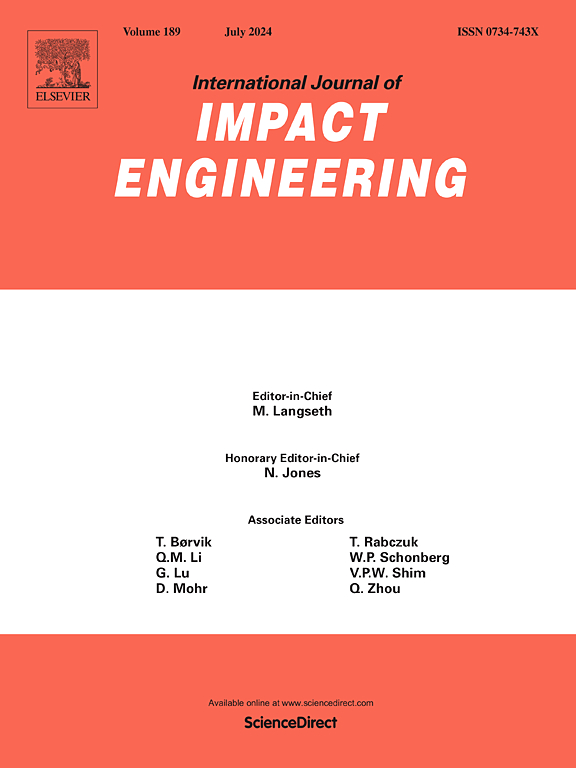花岗岩碎石与UHPC复合材料抗弹丸侵彻性能的实验与数值研究
IF 5.1
2区 工程技术
Q1 ENGINEERING, MECHANICAL
International Journal of Impact Engineering
Pub Date : 2025-05-14
DOI:10.1016/j.ijimpeng.2025.105390
引用次数: 0
摘要
由碎石和胶凝基质组成的复合冲击层具有良好的抗侵彻性和优越的经济效益。然而,这种复合材料的抗渗透机理尚不清楚。对花岗岩碎石与超高性能混凝土复合材料的抗侵彻机理进行了试验与数值结合研究。首先进行了弹丸侵彻复合目标的试验,提供了复合目标侵彻深度、正面弹坑尺寸和截面损伤等有价值的数据;然后,基于随机分布算法、孔方材料模型和SPG算法建立了相应的数值模型,并对所进行的侵彻试验进行了验证。最后利用验证的数值模型研究了花岗岩-碎石粒径、体积分数和材料强度对复合靶抗侵彻性能的影响。数值结果表明,通过优化碎石粒径、提高组成材料强度、降低碎石体积分数,可以提高复合靶材的抗侵彻能力。为平衡抗侵彻性和成本,对工程应用提出了相应的建议。本文章由计算机程序翻译,如有差异,请以英文原文为准。
Experimental and numerical investigation on projectile penetration resistance of a composite material made of granite rubble and UHPC
Composite bursting layer made of rock rubble and cementitious matrix has good penetration resistance and superior cost-effectiveness. However, the anti-penetration mechanism of this composite material is still not well understood. A combined experimental and numerical investigation of the anti-penetration mechanism of a composite material composed of granite rubble and ultra-high-performance concrete was carried out in the present study. Firstly, a test of projectile penetration into the composite target was conducted, which provided valuable data including the penetration depth, frontal crater dimension and cross-sectional damage in the composite target. Then, a corresponding numerical model was established based on the random distribution algorithm, Kong-Fang material model and SPG algorithm, which was validated against the conducted penetration test. The validated numerical model was finally used to investigate influences of granite-rubble size, volume fraction, and material strengths on the penetration resistance of the composite targets. Numerical results demonstrated that enhancing penetration resistance of the composite target can be achieved by optimizing rock-rubble size, increasing the strengths of constituent materials, and reducing the volumetric fraction of rock rubble. Corresponding suggestions were given for engineering use as to balance the penetration resistance and cost.
求助全文
通过发布文献求助,成功后即可免费获取论文全文。
去求助
来源期刊

International Journal of Impact Engineering
工程技术-工程:机械
CiteScore
8.70
自引率
13.70%
发文量
241
审稿时长
52 days
期刊介绍:
The International Journal of Impact Engineering, established in 1983 publishes original research findings related to the response of structures, components and materials subjected to impact, blast and high-rate loading. Areas relevant to the journal encompass the following general topics and those associated with them:
-Behaviour and failure of structures and materials under impact and blast loading
-Systems for protection and absorption of impact and blast loading
-Terminal ballistics
-Dynamic behaviour and failure of materials including plasticity and fracture
-Stress waves
-Structural crashworthiness
-High-rate mechanical and forming processes
-Impact, blast and high-rate loading/measurement techniques and their applications
 求助内容:
求助内容: 应助结果提醒方式:
应助结果提醒方式:


